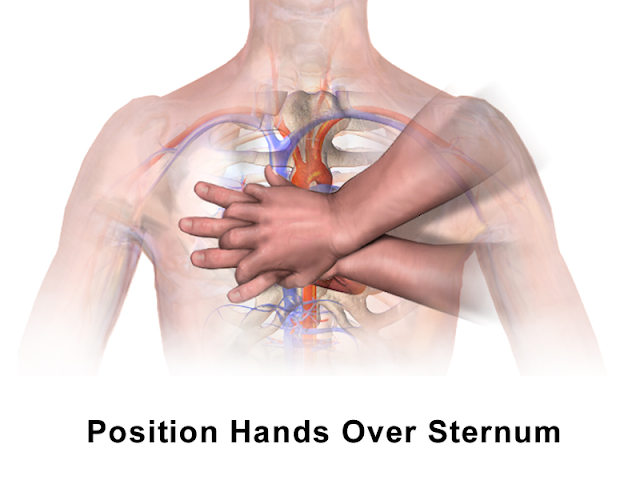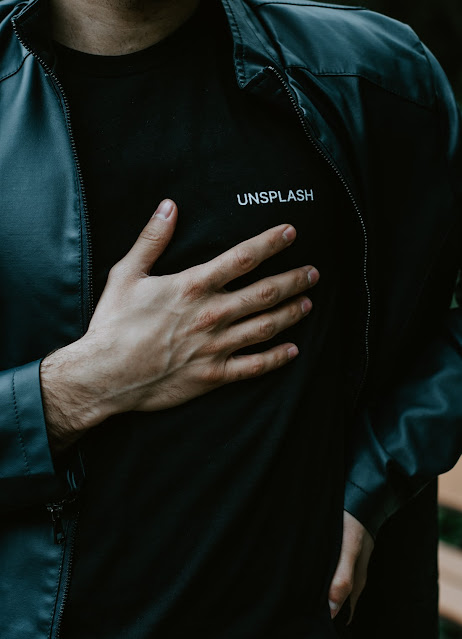Medical Emergency - Don't know how to manage or give first-aid? Here's basic steps for all.
Medical Emergency situations can come anytime to anyone, basic management till reaching health center should be known to everyone.
I m telling 5 situations, where often people either don't know what to do or land up doing something more deteriorating. Everything written below is expected to be done at the moment and by whosoever is near. Immediate care in a simple and efficient way, one should be able to do all these. Look at the list, and know if anything you didn't know.
When you see a person collapsing
✔️ Follow the Basic Life Support Protocol (BLS - CPR)
 |
| Taken from Wikimedia (https://upload.wikimedia.org/wikipedia/commons/0/03/CPR_Adult_Chest_Compression_Heart.png)ion |
- Run immediately to the person
- Call for help
- Check the responsiveness of person by tapping on the shoulder
- Check pulse
- Ask someone to call an ambulance if non-responsive and no pulse felt
- Meanwhile, start CPR immediately
- According to the latest guidelines (until October 21, 2020, if you read after that, look at the changes made) give chest compressions at a rate of 100 - 120 per min.
- Each compression should be of the depth of 2" - 2.4" for adults and should have complete recoil. Minimize any interruption.
- After finishing 30 compressions, give two full breaths. And repeat compressions
- If AED (Automated External Defibrillator) available. Equip it immediately. It has all the instructions. Switch it on.
- Expose the chest and apply electric pads as indicated on the pad itself. There should be the least gap between compressions and applying the AED. So take help from someone around.
- Best is to have one person for each task - giving compressions, breaths and applying pads. Can switch when the person giving compressions get tired, as there should be no compromise in giving compressions.
Heart attack
 |
| Photo by Ashkan Forouzani on Unsplash |
Sign :
- Sudden chest discomfort with heaviness, pressure, crushing or squeezing pain ( diabetes patients may have an asymptomatic heart attack - silent heart attacks)
- Pain radiation to neck, jaw, one or both arms, back, stomach, teeth.
- Maybe with shortness of breath, cold sweats, anxiety, lightheadedness, fatigue, nausea and vomiting.
what to do:
- Call for emergency right away to get an ambulance. Emergency medical services (EMS) personnel can start treatment on the way to the hospital. They’re also trained to revive a person if their heart stops.
- If nothing possible then drive the person to the hospital immediately. Time is very precious here.
- Meanwhile, make the person sit or lie down and make him calm
- Give one adult dose Aspirin - 300mg ( if not allergic to it) to chew (acts faster when chewed compared to when swallowed)
- If the heart stops ( no pulses and patient collapse), remember Basic Life Support Protocol and perform CPR.
COVID-19 Infection

✔️For
- If tested positive
- Have symptoms
- Came in close contact with someone with a positive result or with symptoms
Steps to take:
Stay home and monitor your health.
- Stay home for 14 days after your last contact with a person who has COVID-19
- Watch for fever (100.4◦F), cough, shortness of breath, or other symptoms of COVID-19
- If possible, stay away from others ( in a separate room), especially people who are at higher risk for getting very sick from COVID-19
- Wear a triple layer mask (N95 Mask) all the time, and should be discarded after every 8 hours.
- Drink lots fluid and stay hydrated
- Wash hands frequently with soap and water for at least 40 seconds
- Do not share any items with anyone like plates, combs, towel.
- If immunocompromised, with comorbidities or age more than 60, home isolation only after proper evaluation by a medical officer.
- People should seek immediate medical help if they experience the following:
- Dip in oxygen level using a pulse oximeter
- Slurred speech/seizures
- Weakness in any limb or face
- Difficulty in breathing
- Pain/pressure in the chest
- Bluish discolouration on lips/face
Nose bleed
 |
| Photo by Velizar Ivanov on Unsplash |
Mistakes by a layman- lying down to stop bleeding coming out of the nose.
❌Should never be done. Lying down will let blood go posteriorly and swallowed. This will irritate your stomach. Secondly, won't let you know the amount of nose bleed.
 |
| Taken from Shutterstock (https://www.shutterstock.com/image-vector/wrong-right-first-aid-nasal-bleeding-342097454) |
✔️ Anterior nose bleed: You bleed from the front of your nose
More common, less serious
Can be treated at home easily
- Sit up and lean a little forward
- Squeeze your nose at the soft part just below bone using your fingers. Keep the nostrils close for 10-15 min, while breathing through your mouth.
- Check the bleed after 10-15 minutes. If bleed continues, try again.
- Can apply cold compresses over the nasal bridge, or use nasal decongestant spray.
- It resolves easily mostly, if doesn't report to doctor as it can be posterior bleed as well.
✔️ Posterior nose bleed:
- Bleed from the back end of your nose.
- Less common, more serious
- Blood drips back to your throat in addition to the front of your nose.
- Report to the doctor
Snake bite

✔️ Most of the snakes are non-venomous, and out if venomous only few are significantly fatal. Chances of fatal bites fall to even less. So, first is to not get scared.
Follow the simple steps ( easy to, remember)CARRY NO R.I.G.H.T." It consists of the following:
- CARRY = Do not CARRY = Do not allow the victim to walk even for a short distance; just carry him in any form, especially when the bite is at the leg.
- No- Tourniquate around the limb
- No- Electrotherapy
- No- Cutting of extremities
- No- Pressure immobilization
- R.= Reassure the patient. 70% of all snakebites are from non-venomous species. Only 50% of bites by venomous species actually envenomate the patient.
- I= Immobilize in the same way as a fractured limb.
- G & H = Go to Hospital
- T = Tell the doctor about the symptoms during transportation (and tell the incident, describing snake)






